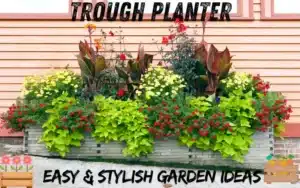Petunias are a popular choice among gardeners as they thrive in various settings like containers, flower beds, landscapes, and hanging baskets. Just follow this guide to easily grow petunia seeds and witness a colorful array of blooms and plant sizes!
What is Petunia Plant?
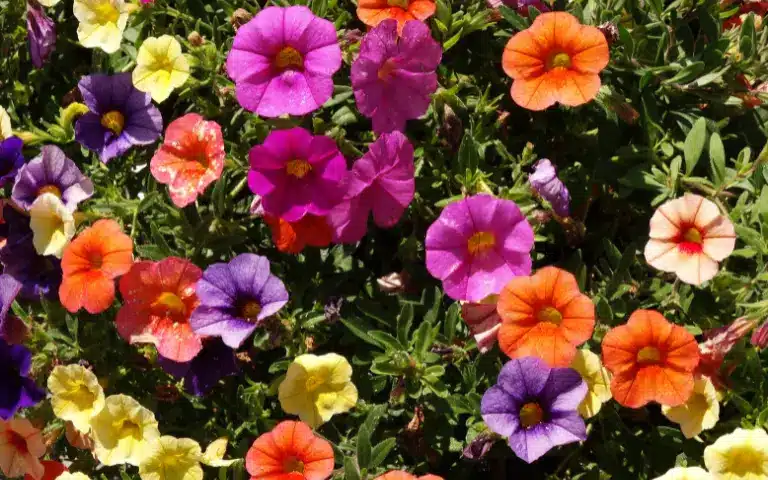
Petunias prefer direct sunlight all day long. They won’t produce as many flowers if they are in the shade. Petunia plants should flower in approximately 80 to 100 days. Petunias are a popular choice for many gardeners. The numerous petunia varieties with vibrant shades and patterns make the options endless! The blooms have a long flowering season, allowing you to enjoy the fresh, beautiful flowers for months.
What do Petunia Seeds Look Like?
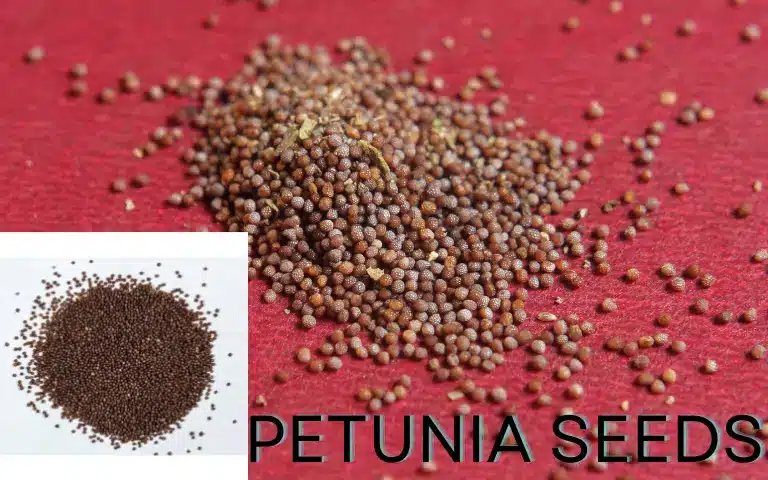
Petunia seeds are super tiny, like really tiny! They’re as small as a pinhead, usually dark brown or black, and might look like dust, but don’t be fooled, they’re full of potential! These seeds are usually in packets or trays labeled with flower variety and color. Just sprinkle them on the soil, barely covering them, and don’t stress about spacing, they’ll sprout up together in a bunch!
Why Choose Petunia Seeds?
- Variety: Petunia seeds give you tons of options! You’re not stuck with just one kind of flower, you can pick from a bunch of different colors, shapes, and sizes to make your dream garden. Check out all the choices:
- Grandiflora: These are the showstoppers! They have big, showy flowers up to 4 inches wide. They’re perfect for adding drama to your garden.
- Milliflora: These are smaller versions of Grandiflora, perfect for containers and window boxes.
- Surfinia: This is where it gets really exciting! Surfinia petunias are trailing varieties. They cascade over the edges of hanging baskets and containers. They’re perfect for a dramatic, spilling effect.
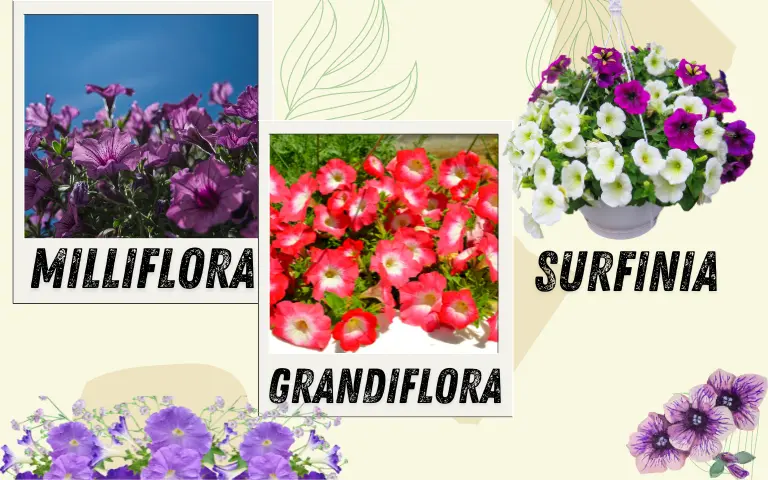
- Easy to Grow: Starting seeds can be a gamble. Petunia seeds are almost guaranteed to succeed! They’re easy to grow, making them a great choice for beginners.
- Affordable: You can get lots of petunia seeds for a few dollars, which is better than buying a single plant for a few dollars. Think about it. You’ll save a lot.
Choosing the Right Petunia Seeds
Before you get carried away and grab the first pack of seeds you see. Always choose seeds of good quality as they have high germination rates, which means more of your seeds will grow into strong, healthy plants.
Know your climate:
Petunias seeds are pretty flexible, but certain types prefer specific conditions. It’s not a good idea to plant a petunia seeds that loves heat in a cold area.
- Consider how much sunlight your garden gets. If it’s sunny most of the time, go for heat-resistant kinds like “Supertunia” or “Million Bells”. These ones can handle the heat and keep blooming throughout the summer.
- For those in cooler areas or with shady spots, Wave or Surfinia petunias might be a better choice. They can handle some shade and still put on a stunning display.

Consider your garden space:
Consider your garden space. You got a small balcony or a sprawling backyard? Petunias come in all shapes and sizes, so there’s a perfect fit for everyone.
- If you’re working with limited space, you’ll want to choose compact varieties like “Superbells” or “Supertunia”. These guys are bushy and full of blooms but don’t take up too much room.
- Got a bigger garden or a hanging basket? Then trailing petunias like “Wave” or “Surfinia” are your best bet. These beauties cascade down and create a breathtaking display of color.
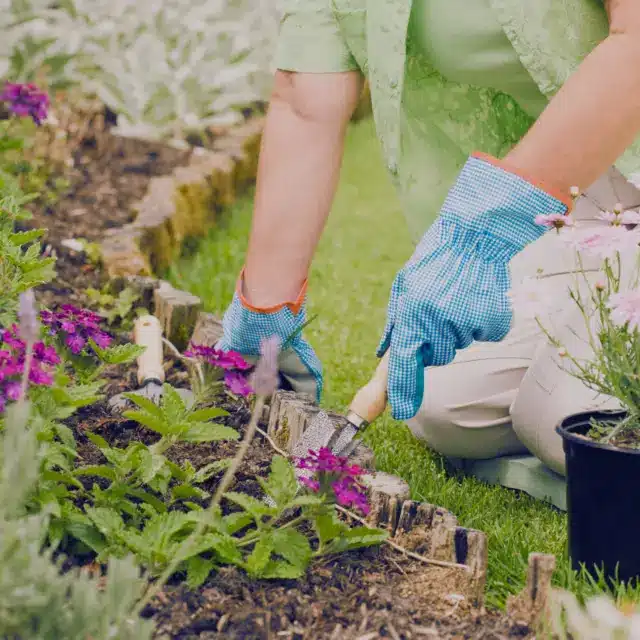
Think about color and bloom time:
You can put together a color scheme for your garden, such as a soothing blend of blues and purples or a lively combination of yellows and oranges.
Of course, you want your petunias to keep blooming, right? Some types, like “Million Bells”, will keep your garden looking gorgeous all summer long. Others, like “Wave”, may bloom earlier but won’t stick around as much.
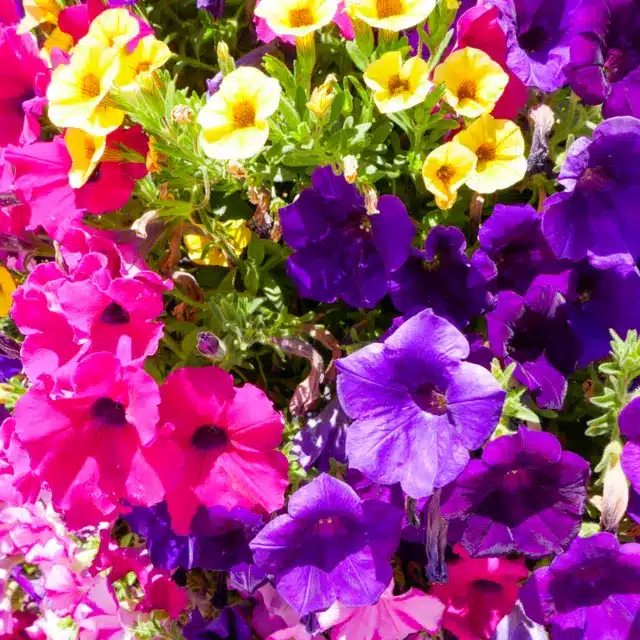
Just check out the petunia seeds packets and read the descriptions. They usually have details about when they bloom and what colors they come in to help you pick the perfect petunias for your garden.
How to Grow Petunias From Seed: A Step-by-Step Guide
Petunia seeds grow best when they are raised in trays or containers and transplanted to the final spot once established.
Starting your petunia seeds indoors
- When to Grow petunia seeds: It’s best to plant petunias anytime from September to November or late January to mid-March.
- Location: Petunia plants are best grown in full sun. Choose a location that will receive at least six hours of full sun each day.
- Preparing the Soil: I use a small container to sow seeds and then plant the seedlings when they’re big enough. Fill the container with a seed-starting mix. Or, make your own by mixing 40% coco peat, 30% compost, and 30% river sand or perlite. Press the soil with a flat object to make an even surface. Moisten the soil mix.
- Sowing the Seeds: Petunia seeds need to be surface-sown, meaning you just sprinkle the seeds on top of the soil medium and provide light or cover them very lightly – just enough to cover the seeds. This will help maintain moisture levels.
- Watering and Care: Once the seeds are planted, lightly water until the soil is moist. Misting or sprinkling the soil works best because pouring water over the seeds can cause them to shift.
- How long does petunia seeds take to germinate? Petunia seeds should germinate in 10 to 12 days. During this phase, keep the soil moist but never wet or dry. Take extra care to make sure seeds and seedlings don’t dry out.
Remember the seeds are very tiny! It’s easy to over-plant the container, ending up with dozens of seedlings you don’t need. Sprinkle them gently on top of the soil, using only a small pinch of seeds.
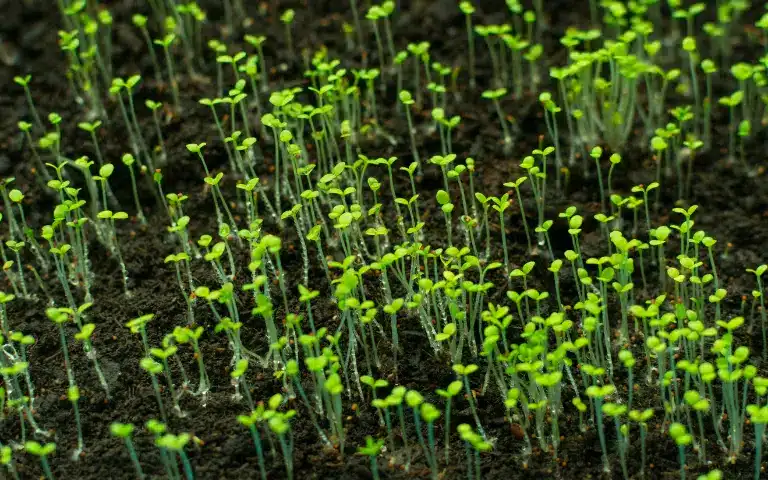
Hardening off petunia seedlings
Your plants need care for another two to three weeks now that they have leaves.
Hardening off helps seedlings adjust to the outdoors. Without this period, they’ll be shocked and stressed, leading to wilting, stunted growth, and even death. Here’s how to harden them off:
- Start by moving your seedlings outside for a bit each day, just find a shady spot. Don’t shock ’em, be gentle when you introduce them to the great outdoors!
- Slowly increase their outdoor time every day, add an extra hour or two each time until they’re out all day.
- Once they’re used to being outside, give them more sunlight bit by bit. Start with morning sun, then work up slowly.
- After they’re comfy with the sun, get ’em used to cooler temps. If they’re in the ground, gradually chill their indoor spot by opening windows or moving them to a cooler area of the house.
Transplanting petunia seedlings
Once they have their true leaves, you can begin the process of transferring them into a larger container. Always transplant your petunias on a cloudy, cool morning. This will stress the plants less than planting on a hot, sunny day.
- Don’t damage the plant or roots. Don’t move the plant much when you take it out of the pot.
- Use a large pot (about 20 to 25 inches wide and 6 to 8 inches deep) to allow the roots to expand and avoid waterlogging. Make sure the pot has drainage holes.
- Petunias need soil with lots of organic matter. Mix 50% garden soil, 30% compost, and 20% river sand.
- Dig a shallow hole and put the root ball in. Untangle the roots and spread them out in the soil.
- While holding the plant in place, add soil around the roots until they are fully covered.
- Water thoroughly! This settles the plants in, drives out air pockets, and results in good root-to-soil contact.
- Let your pot acclimate to the sun for two to three days before placing it in full sun.
Most petunia seeds varieties require at least eight to ten inches between plants for healthy growth. In a big pot around 20 to 24 inches wide, we can easily plant five to seven petunia plants.
How to Collect Petunia Seeds
You have petunias and want to collect the seeds. Here’s how to collect petunia seeds:
- Wait for the flowers to die.
- Once the petals fall off, you’ll see a green capsule. This is the seed pod.
- Don’t rush it! Let them dry on the plant. This takes a few weeks.
- When the pods are dry, twist them off the plant and put them in a bag.
- Store the pods in a dry place to prevent mold.
- Store the petunia seeds in a cool, dry place. Use a paper bag or airtight container.
- Write the variety and date on the seeds.
- Save your petunia seeds next year. It’s easy!
8 Tips for Better Petunias
Today I’m sharing my top tips for growing giant patunas. I’ve had great success with these, so I’m excited to share what I’ve learned.
1. Fertilizer is important!
People often underestimate how much petunias need to eat. Petunias love fertilizer!
- I put time-release fertilizer in there once a month. I usually choose the ones with bloom boosters, but any fertilizer is good. Bloom boosters help flowers produce more flowers. That’s why I use them.
- Some people have a more scientific approach. Some people add fertilizer to their water once every third watering. They find this consistency works well as the season goes on. If they need more water, they add more fertilizer because the plants are taking up more water.
2. Give petunias room to grow!
The next thing I’ll tell you about is pot size. People often get this wrong. They’ll go to a big box store and get an 8 or 10-inch pot with four or five plants. Let me tell you:
- If you put four petunias in an 8-inch pot, it’ll look great at first, but you won’t be able to keep it watered in the hottest part of the season. You’ll need to water it three times a day to survive! If you use an 8-inch pot, put one petunia in it. It will fill it out nicely.
- I use 12- or 14-inch pots for petunias. Different varieties need different amounts of space. If you do it over time, your plant will get bigger.
If it’s a Supertunia Vista, it’s a big variety. I put one in a 12- or 14-inch pot and they fill out nicely. If I’m doing one in just one color, I’ll put two in and they’ll fill out. That’s true of many vigorous varieties.
3. Don’t settle for just any petunia!
I’ll talk about the different types. People will say, “It doesn’t matter!” A petunia is a petunia. Some petunia varieties are better than others. Not all are the same!
- Some of my favorite varieties are Supertunia, Surfinia, and Superbells. Superbells are a cross between a Calibrachoa and a petunia. They look like petunias, especially the Premiums. There are also other varieties, such as Cascadas, Sanguna, Headliner, Flower Showers, Funhouse, and Durabloom Wave. Wave is very popular. They all do well.
- If you don’t mind smaller flowers, there’s Deco, Itsy, and the yellow PCO. Those are smaller flowers that cascade over the edge of a pot. I like all these varieties. There are hundreds of varieties, so you’re not limited to these. Crazytunia’s are cool colors and get big. If I think about it, I’ll probably think of another 20 varieties, but those are the ones I mentioned are going to be my favorites.
If you have a seed variety that works well for you, let me know. The most popular petunia seed is Wave. It’s reliable and I’ve grown it many times.
4. Water wisely, but don’t be afraid of a dry down!
Keep them moist. They just like staying damp. They can handle a dry down. If you miss a watering and they dry out, they’ll be fine. If they start to droop, you should catch them in time. They usually recover, but sometimes you have to wait two weeks for them to bounce back. At least they don’t die. They’re drought-tolerant, but they might not look as good for a while.
5. Deadheading for continued blooms
A snip off the dead flower, just above the leaf node, is all it takes. Removing old flowers regularly will encourage plants to produce more flowers. Regular deadheading, however, channels the energy into the flowers. This results in healthier plants, more flowers, and an extended growing season.
6. Weed control
Weeds can spread almost like wildfire, choking your desirable plants and depleting the soil of nutrients. Keep weeds under control during the growing season. When weeds are pulled, any root stem or pieces left behind in the soil can re-sprout into another weed. To put it basically: you have to get the entire root or the weed will grow back.
7. Be prepared for pests, but don’t panic!
Watch out for pests! Petunias have earwigs that eat the inside of flowers. We use Sluggo Plus to treat them. Check the packaging for an organic solution. Put a couple of pellets in, don’t use a lot, and it’ll take care of the earwigs. It also keeps snails off.
In other parts of the country, people have a big problem with budworm. You can spray with a product called BT. It’s also an organic product. You don’t have to use harsh chemicals to treat these. You just have to spray BT once a week.
I haven’t had problems with deer eating my petunias. They go after the plants next to it, but not the petunias. Hopefully, you won’t have that problem because it’d be hard to spray petunias with a deer repellent.
8. Troubleshooting: Don’t give up!
- My petunias do well in part-sun and part-shade areas, as long as they get lots of direct sunlight. I think I’ve pushed it to four hours, but there are fewer flowers. They like six hours of sun.
- People say that petunias don’t do well. Look for ugly parts, trailing stems, or leggy plants. Trim them back, usually by about 20-25%. If they’re very bad, I cut them back to the pot. They take longer to recover, but they’ll look good again.
- You can give them water-soluble fertilizer and they should start growing in a couple of days. You’ll see new growth in a week to 10 days.
- Petunia plants will need frequent watering during the growing season. Water when the soil is dry about one to two inches below the surface. Test this by scratching away a little soil with your fingers.
Growing petunias from seed is a cool way to kick off the season early, save some cash, and have a wider range of flowers to choose from.
No matter where you decide to plant petunia seeds, they’ll keep blooming like crazy, even in the hot summer! Petunias are super easy to grow, especially from seed. So, don’t stress – just give it a shot! Who knows, you might find a new petunia fave.
So, what petunia types do you like best? Any tips for growing them from seed? We’re all ears for your petunia stories! Drop your thoughts and experiences in the comments below.
Interested in what’s up with petunias? Just sign up for our newsletter to get gardening tips and ideas. You’ll receive all the latest advice on keeping your garden in top shape throughout the year.
Frequently Asked Questions
Are petunia seeds edible?
Nah, you can’t munch on petunia seeds. They won’t make you sick or anything, but they’re not gonna be a yummy snack either.
Why are my petunia seeds not germinating?
- First, make sure your seeds are fresh. Petunia seeds can lose their viability over time.
- Check the temperature. Petunia seeds need warm soil to germinate.
- Petunia seeds need good air circulation to germinate. If the soil is too dense, they might not be able to push their way through. Make sure your soil is loose and well-drained.
- Did you water them too much? Petunia seeds need moisture to germinate, but too much water can actually suffocate them.
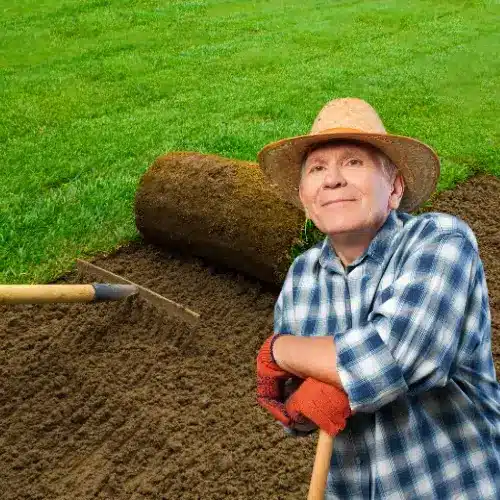
About the Author
Experienced gardener with 20 years’ expertise in home gardens.
I share with you tips and tricks I’ve learned over the years to help keep your plants happy and healthy.


